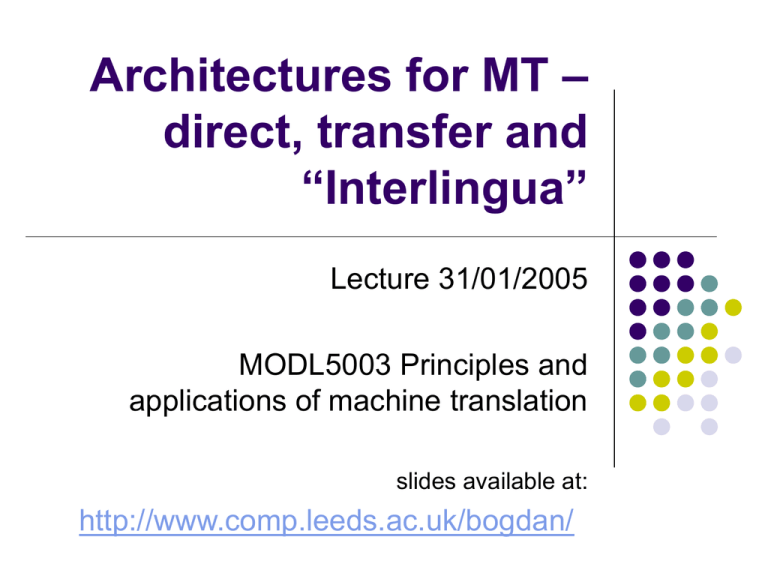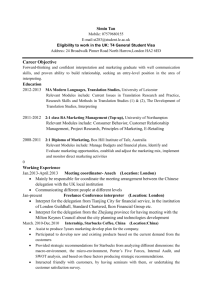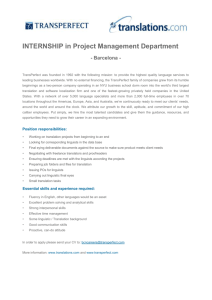Architectures for MT – direct, transfer and “Interlingua”
advertisement

Architectures for MT – direct, transfer and “Interlingua” Lecture 31/01/2005 MODL5003 Principles and applications of machine translation slides available at: http://www.comp.leeds.ac.uk/bogdan/ 1. Overview Classification of approaches to MT Architectures of rule-based MT systems the MT triangle Reviewing each architecture and its problems Architectures compared Limits of MT 2. Revision of MT problems & how to deal with them: 1/3 Rule-based approaches (lecture today) Use formal models of our knowledge of language Direct MT Transfer MT Interlingua MT to explicate human knowledge used for translation, put it into an “Expert System” Problems expensive to build require precise knowledge, which might be not available 2. Revision of MT problems & how to deal with them: 2/3 Corpus-based approaches (lecture 25/04/2005) Example-based MT Statistical MT Use machine learning techniques on large collections of available texts; e.g. "parallel texts" (aligned sentence by sentence; phrase by phrase) "to let the data speak for themselves“ recent decade: shift into this direction: IBM MT system Problems: language data are sparse (difficult to achieve saturation) high-quality linguistic resources are also expensive 2. Revision of MT problems & how to deal with them: 3/3 Corpus-based support for rule-based approaches current state-of-the-art technology Speeding up the process of rule-creation by retrieving translation equivalents automatically 3. Architectures of MT systems (the MT triangle*) * Other linguistic engineering technologies also have similar "triangle" hierarchy of architectures: e.g., Text-to-Speech triangle **Interlingua = language independent representation of a text 4. Direct systems Essentially: word for word translation with some attention to local linguistic context No linguistic representation is built (historically come first: the Georgetown experiment 1954-1963: 250 words, 6 grammar rules, 49 sentences) Sentence: The questions are difficult (P.Bennett, 2001) (algorithm: a "window" of a limited size moves through the text and checks if any rules match) 1. the <[N.plur]> les /*before plural noun*/ 2. <[article]> questions [N.plur]/*'questions' is plur. noun after the questions article */ 3. <[not: "we" or "you"]> are /* unless it follows the words "we" or sont "you"*/ 4. <are> difficult difficilles /*when it follows 'are'*/ A. technical problems with direct systems: 1/4 (“direct”=without intermediate representation) rules are "tactical", not "strategic" (do not generalise) for each word-form (a member of a paradigm ) a separate set of rules is required rules have little linguistic significance there is no obvious link between our ideas about translation knowledge and the formalism it is hard to "think of" an accurate set of "direct" rules and to encode them manually A. Technical problems with direct systems: 2/4 dealing with highly inflected languages becomes difficult e.g., Russian: 90.000 dictionary entries (lexemes, lemmas, headwords) have about 4.000.000 word forms Should there be 4.000.000 sets of rules for translation from Russian? What happens if we translate between two highly inflected languages? combinatorial grow of the number of rules: Any Russian adjective (24 wfs) can be translated by a German adjective (16 wfs): 24*16=384 rules ? A. Technical problems with direct systems: 3/4 large systems become difficult to maintain and to develop: systems becomes non-manageable avoiding new errors when new features are introduced interaction of a large number of rules: rules are not completely independent it is difficult to find out whether the set of rules is complete A. Technical problems with direct systems: 4/4 no reusability a new set of rules is required for each language pair no knowledge can be reused for new language pairs a multilingual system that translates in both directions between all language pairs: n × (n – 1) modules e.g., 5 languages = 20 modules with complex directionspecific sets of rules B. Linguistic problems with direct systems: sometimes information for disambiguation appears not locally (not in the immediate context) (the length of the disambiguating context is not possible to predict) B1. LEXICAL AMBIGUITY/ LEXICAL MISMATCH B2. STRUCTURAL AMBIGUITY / STRUCTURAL MISMATCH B1. LEXICAL MISMATCH: 1/2 Das ist ein starker Mann This is a strong man Es war sein stärkstes Theaterstück It has been his best play Wir hoffen auf eine starke Beteiligung We hope a large number of people will take part Eine 100 Mann starke Truppe A 100 strong unit Der starke Regen überraschte uns We were surprised by the heavy rain Maria hat starkes Interesse gezeigt Mary has shown strong interest Paul hat starkes Fieber Paul has high temperature Das Auto war stark beschädigt The car was badly damaged Das Stück fand einen starken The piece had a considerable response Widerhall Das Essen was stark gewürzt The meal was strongly seasoned Hans ist ein starker Raucher John is a heavy smoker Er hatte daran starken Zweifel He had grave doubts about it (example by John Hutchins, 2002) B1. LEXICAL MISMATCH: 2/2 The questions are hard (ex. by P.Bennett) hard difficile dur What kind of information do we need here? What happens if we have a complex sentence? The questions she tackled yesterday seemed very hard To bake tasty bread is very hard B2. STRUCTURAL MISMATCH 1. The question N changes every day V Ukr.: Питання N.nom міняється. V щодня Pytann'a .N.nom min'ajet's'a. V shchodn'a 2. The question .N changes have been agreed N Ukr.: 3. The question .N changes have been difficult N Ukr.: Зміну . N.acc. питань N.gen було погоджено Zminu N.acc pytan' N.gen bulo pohodzheno Змін а . N.nom. питань N.gen бул а складною Zmin a N.nom pytan' N.gen bul a skladnoju translation of the word question is also different, because its function in a phrase has changed translation might depend on the overall structure even if the function does not change in the English sentence Generally: Meaning is not explicitly present "The meaning that a word, a phrase, or a sentence conveys is determined not just by itself, but by other parts of the text, both preceding and following… The meaning of a text as a whole is not determined by the words, phrases and sentences that make it up, but by the situation in which it is used". M.Kay et. al.: Verbmobil, CSLI 1994, pp. 11-1 Advantages of the direct systems Saving resources Machine-learning techniques could be applied straightforwardly to create a direct MT system Translation is much faster & requires less memory Direct rules are easier to learn automatically Generalisations and intermediate representations are difficult for machine learning Taking advantage of structural similarity between languages similarity is not accidental – historic, typological, based on language and cognitive universals high quality of MT can be achieved 5. Indirect systems 5. Indirect systems linguistic analysis of the ST some kind of linguistic representation (“Interface Representation” -- IR) ST Interface Representation(s) TT Transfer systems: -- IRs are language-specific -- Language-pair specific mappings are used Interlingual systems: -- IRs are language-independent -- No language-pair specific mappings 6. Transfer systems Involve 3 stages: analysis - transfer – synthesis Analysis and synthesis are monolingual and independent, i.e.: analysis is the same irrespective of the TL; synthesis is the same irrespective of the SL - Transfer is bilingual, and each transfer module is specific to a particular language-pair (e.g., “Comprendium” MT system – SailLabs) Synthesis (generation) is straightforward The number of modules for a multilingual transfer system n × (n – 1) transfer modules n × (n + 1) modules in total e.g.: 5-language system (if translates in both directions between all language-pairs) has 20 transfer modules and 30 modules in total There are more modules than for direct systems, but modules are simpler Advantages of transfer systems: 1/2 reusability of Analysis and Synthesis modules = separation of reusable (transfer-independent) information from language-pair mapping operations performed on higher level of abstraction the tasks: to do as much work as possible in reusable modules of analysis and synthesis to keep transfer modules as simple as possible = "moving towards Interlingua" Advantages of transfer systems: 2/2 can generalise over features, lexemes, tree configurations, functions of word groups can view the features & how they relate to each other lexical items are replaced and the features are copied no need to translate each inflected word form: the lexicon for transfer becomes smaller Transfer: dealing with lexical and structural mismatch, w.o.: 1/2 Dutch: Jan zwemt English: Jan swims Dutch: Jan zwemt graag English: Jan likes to swim (lit.: Jan swims "pleasurably", with pleasure) Spanish: Juan suele ir a casa English: Juan usually goes home (lit.: Juan tends to go home, soler (v.) = 'to tend') English: John hammered the metal flat French: Jean a aplati le métal au marteau Resultative construction in English; French lit.: Jean flattened the metal with a hammer Transfer: dealing with lexical and structural mismatch, w.o.: 2/2 English: The bottle floated past the rock Spanish: La botella pasó por la piedra flotando (Spanish lit.: 'The bottle past the rock floating') English: The hotel forbids dogs German: In diesem Hotel sind Hunde verboten English: The trial cannot proceed German: Wir können mit dem Prozeß nicht fortfahren (German lit.: Dogs are forbidden in this hotel) (German lit.: We cannot proceed with the trial) English: This advertisement will sell us a lot German: Mit dieser Anziege verkaufen wir viel (German lit.: With this advertisement we will sell a lot) Is word for word translation possible? English: 10 pounds will buy you decent milk … (translate into German, Russian, Japanese…) (English has fewer constraints on subjects) English: "to call a spade a spade" English: "to kick the bucket" Conclusion: higher quality of translation is achievable even for structurally different languages Transfer: open questions Depth of the SL analysis Nature of the interface representation (syntactic, semantic, both?) Size and complexity of components depending how far up the MT triangle they fall Nature of transfer may be influenced by how typologically similar the languages involved are the more different -- the more complex is the transfer Principles of Interface Representations (IRs) IRs should form an adequate basis for transfer, i.e., they should contain enough information to make transfer (a) possible; (b) simple provide sufficient information for synthesis need to combine information of different kinds 1. lematisation 2. freaturisation 3. neutralisation 4. reconstruction 5. disambiguagtion IR features: 1/3 1. lematisation each member of a lexical item is represented in a uniform way, e.g., sing.N., Inf.V. (allows the developers to reduce transfer lexicon) 2. freaturisation only content words are represented in IRs 'as such', function words and morphemes become features on content words (e.g., plur., def., past…) inflectional features only occur in IRs if they have contrastive values (are syntactically or semantically relevant) IR features: 2/3 3. neutralisation neutralising surface differences, e.g., surface properties are represented as features active and passive distinction different word order (e.g., voice = passive) possibly: representing syntactic categories: E.g.: John seems to be rich (logically, John is not a subject of seem): = It seems to someone that John is rich Mary is believed to be rich = One believes that Mary is rich translating "normalised" structures IR features: 3/3 4. reconstruction to facilitate the transfer, certain aspects that are not overtly present in a sentence should occur in IRs especially, for the transfer to languages, where such elements are obligatory: John tried to leave: S[ try.V John.NP S[ leave.V John.NP]] 5. disambiguagtion ambiguities should be resolved at IR, e.g., attachment of PPs. Lexical ambiguities can be annotated with numbers: table_1, _2… 7. Interlingual systems 7. Interlingual systems involve just 2 stages: analysis synthesis both are monolingual and independent there are no bilingual parts to the system at all (no transfer) generation is not straightforward The number of modules in an Interlingual system A system with n languages (which translates in both directions between all language-pairs) requires 2*n modules: 5-language system contains 10 modules Features of “Interlingua” Each module needs to be more complex universal IR (not specific to particular languages) IL based on universal semantics, and not oriented towards any particular family or type of languages IR principles still apply (even more so): more work on the analysis part Neutralisation must be applied cross-linguistically, different surface realisations of the same meaning being mapped into one single IR no lexical items, just universal semantic primitives: (e.g., kill: [cause[become [dead]]]) From transfer to interlingua En: Luc seems to be ill Fr: *Luc semble être malade Fr: Il semble que Luc est malade SEEM-2 (ILL (Luc)) SEMBLER (MALADE (Luc)) (Ex.: by F. van Eynde) Problem: the translation of predicates: Solution: treat predicates as language-specific expressions of universal concepts SHINE = concept-372 SEEM = concept-373 BRILLER = concept-372 SEMBLER = concept-373 Problems with Interlingua: why IL does not work as it should? Semantic differentiation is target-language specific runway startbaan, landingsbaan (landing runway; take-of runway) cousin cousin, cousine (m., f.) No reason in English to consider these words ambiguous making such distinctions is comparable to lexical transfer not all distinctions needed for translation are motivated monolingually: no "universal semantic features“ Concepts may be not ambiguous in the source language, but -- ambiguous in the other languages Adding a new language requires changing all other modules = exactly what we tried to avoid 8. Transfer and Interlingua compared Much work is the same for both approaches Translation vs. paraphrase translation is limited by conflicting restrictions fluency considerations by adequacy considerations Bilingual contrastive knowledge is central to translation translators know about contrast of languages know correct systems of correspondences, e.g., legal terms, where "retelling" is not an option Transfer systems can capture contrastive knowledge IL leaves no place for bilingual knowledge can work only in syntactically and lexically restricted domains … Transfer and Interlingua compared Transfer has a theoretical background, it is not an engineering ad-hoc solution, a "poor substitute for Interlingua". It must be takes seriously and developed through solving problems in contrastive linguistics and in knowledge representation appropriate for translation tasks". Whitelock and Kilby, 1995, p. 7-9 9. Limitations of the state-ofthe-art MT architectures Q.: are there any features in human translation which cannot be modelled on computers in principle (e.g., even if dictionary and grammar are complete and “perfect”)? MT architectures are based on searching databases of translation equivalents, cannot invent novel strategies add / removing information prioritise translation equivalents trade-off between fluency and adequacy of translation Information redundancy 1/2 Source Text and the Target Text usually are not equally informative: Redundancy in the ST: some information is not relevant for communication and may be ignored Redundancy in the TT: some new information has to be introduced (explicated) to make the TT wellformed e.g.: MT translating “communicatively redundant” etymology of proper names: “Bill Fisher” => “to send a bill to a fisher” Information redundancy 2/2 ORI: Bayern began with the verve which saw them come from behind to defeat Celtic FC a fortnight ago. MT: Bayern начался с воодушевления, которое видело, что они прибыли из-за нанести поражение Кельтскому FC две недели назад (Bayern began with an inspiration which saw, that they arrived from behind to defeat Celtic FC two weeks ago.) HT: Гости, две недели назад одержавшие волевую победу над "Селтиком", с первых минут завладели инициативой. (Guests, who two weeks ago gained a strong-willed victory over “Celtic”, from the first minutes took the initiative.) ignoring “verve saw”;preserving more important information 10. MT and human understanding Cases of “contrary to the fact” translation ORI: Swedish playmaker scored a hat-trick in the 42 defeat of Heusden-Zolder MT: Шведский плеймейкер выиграл хет-трик в этом поражении 4-2 Heusden-Zolder. (Swedish playmaker won a hat-trick in this defeat 4-2 Heusden-Zolder) In English “the defeat” may be used with opposite meanings, needs disambiguation: “X’s defeat” “X’s defeat of Y” == X’s loss == X’s victory … MT and human understanding MT is just an “expert system” without real understanding of a text… What is real understanding then? Can the “understanding” be precisely defined and simulated on computers?






